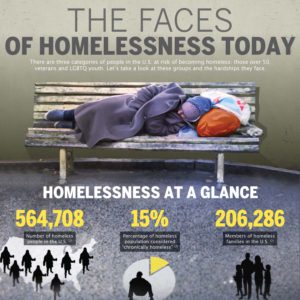The Homelessness Today infographic depicts the faces of homelessness that are so prevalent throughout the US.
Homelessness Today Infographic
The Faces of Homelessness Today
There are three categories of people in the U.S. at risk of becoming homeless: those over 50, veterans, and LGBTQ youth. Let’s take a look a closer look at these groups and the hardships they face.
Homelessness at a Glance
564,708 – Number of homeless people in the U.S.
15% – Percentage of the homeless population considered “chronically homeless”
206,286 – Members of homeless families in the U.S. California’s homeless percentage, 20%, is the highest in the country.
High-Risk Populations
Age 50+
Homeless people aged 50+ face complications due to geriatric syndromes that include:
- Falls
- Cognitive impairment
- Sensory impairment
- Urinary incontinence
- Physical frailty
- Major depression
- Diseases like diabetes and arthritis
Percentage of homeless age 50 and older
- 1990s: 11%
- 2003: 37%
- Today: 50%
- 3.9% – Unemployment rate for Americans 55+
Veterans
War-related disabilities or disorders often contribute to veteran homelessness, including:
- Physical disability
- PTSD
- Traumatic brain injury
- Depression and anxiety
- Addiction
8% – Percentage of homeless people who are veterans
35.8% – Percentage of homeless veterans who remain unsheltered. Washington D.C. has the highest rate of veteran homelessness, at 145.8 homeless vets per 10,000.
45% – Percentage of homeless veterans who are black or Hispanic
1.4 million – Number of veterans at risk of homelessness due to poverty, overcrowding in government housing and lack of support networks
50% – Percentage of homeless veterans with serious mental illness
LGBTQ youth
110,000 – Number of homeless LGBTQ youth in the U.S.
20% – Percentage of runaway and homeless youth who identify as LGBTQ
40% – Percentage of LGBTQ youth who say they live in a community that is not accepting of LGBTQ people. LGBTQ youth are twice as likely to be physically bullied at school.
Top reasons for LGBTQ youth homelessness
- Family rejection : 46%
- Forced out by parents: 43%
- Abuse at home: 32%
- Aged out of foster care: 17%
- Neglect from family: 14%
58.7% – Percentage of homeless LGBTQ youth who have been sexually victimized, compared to 33.4% of heterosexual homeless youth.
62% – LGBTQ homeless youth suicide rate, compared to 29% among heterosexual homeless youth.
Pages for Infographics:
- Child Abuse in the USA
- How Poverty Burdens the Brain
- Left in a Right World
- Poverty in America: Then and Now
- Romanticizing Poverty
- Smoke Without Fire
- Social Work Leaders: The Crisis in Social Work
- Suicide Notes
- The Faces of Homelessness Today
- The Social Impact Of Mixing Business & Medicine
- The State of Children’s Health
- The War Within: Sexual Abuse in the Military
- Who Needs Social Workers?



